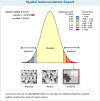Spatial distribution and associated factors of dropout from health facility delivery after antenatal booking in Ethiopia: a multi-level analysis
- PMID: 36823622
- PMCID: PMC9948476
- DOI: 10.1186/s12905-023-02229-y
Spatial distribution and associated factors of dropout from health facility delivery after antenatal booking in Ethiopia: a multi-level analysis
Abstract
Background: Nowadays, retaining women in the continuum of care throughout the lifecycle: adolescence, pregnancy, childbirth, postpartum, and childhood in reproductive health is one of the recent global concerns. Most of the previous studies focused on individual-level factors and used classical logistic regression. Furthermore, it doesn't take into account its distribution. Therefore, this study aimed to assess spatial distribution, and associated factors of dropout from health facility delivery after antenatal booking among postpartum women in Ethiopia.
Method: Cross-sectional study by secondary analysis of the Ethiopian Mini Demographic and Health Survey (EMDHS) 2019 dataset was conducted among postpartum women. A total of 2882 women who gave birth 5 years prior to the survey were included. Sampling weight was applied and the analysis was done using STATA version 16. Aeronautical Reconnaissance Coverage Geographic Information System (ArcGIS) 10.8 software was used to map the cluster and attribute of dropout from health facility delivery and Global and local Moran's Index methods were used to assess the extent of clustering. Multi-level (two-level) logistic regression analysis was used and variables with a P value less than 0.5 were considered statistical significance. Adjusted odds ratio AOR) with a 95% confidence interval was used to show the strength and direction of the association respectively.
Results: Dropout from health facility delivery after ANC (Antenatal Care) booking in Ethiopia was 35.42%, 95% CI (33.70, 37.19), and it spatially clustered (Moran's index = 0.51, P value < 0.001). From individual-level variables: women who were primary educated [AOR = 0.70, 95% CI (0.49, 0.98)], secondary educated [AOR = 0.38, 95% CI (0.19, 0.73)], lived in the middle [AOR = 0.54, 95% CI (0.29, 0.98)], richer wealth [AOR = 0.37, 95% CI (0.18, 0.78)], richest wealth [AOR = 0.21, 95% CI (0.06, 0.74)], being counseled about pregnancy and childbirth complications [AOR = 0.52, 95% CI (0.34, 0.80)] and women who had four and above ANC visit [AOR = 0.52, 95% CI (0.38, 0.71)] were negatively associated with dropout. Whereas, second birth order [AOR = 2.62, 95% CI (1.40, 4.89)], 3-4th birth order [AOR = 4.92, 95% CI (2.82, 8.60)], above 4th birth order [AOR = 4.77, 95% CI (2.16, 10.53))] were positively associated with dropout. From community-level variables: mothers who lived in Afar [AOR = 2.61, 95% CI (1.08, 6.32)] and Oromia [AOR = 2.63, 95% CI (1.15, 6.02)] were positively associated with dropout from health facility delivery after ANC booking.
Conclusions: Dropout from health facility delivery after ANC booking was high as the government's effort and its spatial distribution in Ethiopia was clustered. Increased educational status of the mother, having four or more ANC visits, counseled about pregnancy and childbirth complications, and higher household wealth were negatively associated and higher birth order, and living in Oromia and Afar region were positively associated with dropout in Ethiopia. Strengthening women's education, encouraging women to complete ANC visits, being counseled them on pregnancy and childbirth complications, and improving family wealth status will be the recalled intervention areas of the government.
Keywords: Continnum of care; Dropout; Ethiopia; Health facility delivery; Home delivery; Multi-level analysis; Spatial analysis.
© 2023. The Author(s).
Conflict of interest statement
The authors declared that they have no competing interest.
Figures








Similar articles
-
Spatial clustering and determinants of home birth after at least one antenatal care visit in Ethiopia: Ethiopian demographic and health survey 2016 perspective.BMC Pregnancy Childbirth. 2020 Feb 11;20(1):97. doi: 10.1186/s12884-020-2793-6. BMC Pregnancy Childbirth. 2020. PMID: 32046677 Free PMC article.
-
Spatial variation and factors associated with home delivery after ANC visit in Ethiopia; spatial and multilevel analysis.PLoS One. 2022 Aug 25;17(8):e0272849. doi: 10.1371/journal.pone.0272849. eCollection 2022. PLoS One. 2022. PMID: 36007083 Free PMC article.
-
Determinants of optimal antenatal care visit among pregnant women in Ethiopia: a multilevel analysis of Ethiopian mini demographic health survey 2019 data.Reprod Health. 2022 Mar 5;19(1):61. doi: 10.1186/s12978-022-01365-2. Reprod Health. 2022. PMID: 35248079 Free PMC article.
-
Institutional delivery service utilization and associated factors in Ethiopia: a systematic review and META-analysis.BMC Pregnancy Childbirth. 2020 Jun 15;20(1):364. doi: 10.1186/s12884-020-03032-5. BMC Pregnancy Childbirth. 2020. PMID: 32539698 Free PMC article.
-
Predictors of Birth Preparedness and Complication Readiness Practices Among Pregnant Women in Ethiopia, a Systematic Review and Meta-Analysis.Int J Public Health. 2024 Sep 2;69:1607296. doi: 10.3389/ijph.2024.1607296. eCollection 2024. Int J Public Health. 2024. PMID: 39286757 Free PMC article.
Cited by
-
Women in low- and middle-income countries receive antenatal care at health institutions, yet not delivered there: a multilevel analysis of 2016-2021 DHS data.Trop Med Health. 2024 Jan 2;52(1):1. doi: 10.1186/s41182-023-00561-5. Trop Med Health. 2024. PMID: 38163909 Free PMC article.
-
Pregnancy to postpartum: Analyzing dropouts and socioeconomic predictors of continuum of maternal healthcare in India.Dialogues Health. 2025 Jul 1;7:100226. doi: 10.1016/j.dialog.2025.100226. eCollection 2025 Dec. Dialogues Health. 2025. PMID: 40688797 Free PMC article.
-
Spatial distribution and determinants of children ever born among reproductive age women in Ethiopia: spatial and multilevel analysis of 2019 mini Ethiopian demographic health survey.Front Reprod Health. 2025 Feb 10;7:1389932. doi: 10.3389/frph.2025.1389932. eCollection 2025. Front Reprod Health. 2025. PMID: 39995814 Free PMC article.
References
-
- de Graft-Johnson J, Kerber K, Tinker A, Otchere S, Narayanan I, Shoo R, et al. The maternal, newborn and child health continuum of care. Oppor Afr Newborns. 2006;2011:23–36.
MeSH terms
LinkOut - more resources
Full Text Sources
Medical

